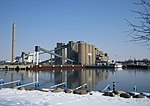Øresund Region

The Øresund Region (Danish: Øresundsregionen [ˈøːɐsɔnsʁekiˌoˀnn̩]; Swedish: Öresundsregionen [œːrɛˈsɵ̂nːdsrɛɡɪˌuːnɛn]), also known as Greater Copenhagen for marketing purposes, is a metropolitan region that comprises eastern Denmark and Skåne in southern Sweden. Centred around the Øresund strait and the two cities which lie on either side, Copenhagen in Denmark and Malmö in Sweden, the region is connected by the Øresund Bridge, which spans the strait at its southern end, and the HH Ferry route between Helsingør, Denmark, and Helsingborg, Sweden, at the narrowest point of the strait. The Capital Region of Denmark and Region Zealand constitute the Danish side, while Scania constitutes the Swedish side. The region has a population of 4,002,372 (2018) and a population density of 192/km2 (500/sq mi).Since the Treaty of Roskilde of 1658, Scania (Swedish: Skåne) has been subordinate to the King of Sweden, except during the Scanian War (1676–79) and briefly in 1710, but it only became a province of Sweden under the Treaty of Stockholm 1720 (dated 3 July 1720). From 800 to 1658, Greater Copenhagen was united under the flag of Denmark, although in the early years Denmark sometimes had several local kings. In recent years, part of the population has stressed Scania's regional identity again.The Øresund Region consists of both rural and urban areas. Areas on the periphery of the region have a relatively low population density, whereas the two metropolitan areas of Copenhagen and Malmö are two of the most densely populated in Scandinavia. Helsingborg also forms an important urban hub on the Swedish side.
Excerpt from the Wikipedia article Øresund Region (License: CC BY-SA 3.0, Authors, Images).Øresund Region
Malmö kommun
Geographical coordinates (GPS) Address Nearby Places Show on map
Geographical coordinates (GPS)
| Latitude | Longitude |
|---|---|
| N 55.566666666667 ° | E 12.816666666667 ° |
Address
Malmö kommun (Malmö stad)
Malmö kommun
Sweden
Open on Google Maps









